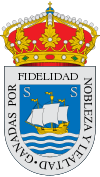San Sebastián
| Donostia-San Sebastián | |||
|---|---|---|---|
 |
|||
|
|||
| Nickname(s): Sanse, Donosti, San Seb, La Bella Easo[1] | |||
| Motto: «Por fidelidad, nobleza y lealtad ganadas (Spanish for "Won by fidelity, nobility and loyalty") |
|||
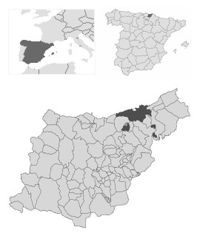 |
|||
| Coordinates: | |||
| Country | Spain | ||
| Autonomous community | Autonomous Community of the Basque Country | ||
| Province | Gipuzkoa | ||
| Neighbourhoods | 21 | ||
| Founded | 1180 | ||
| Government | |||
| - Mayor | Odón Elorza (PSOE) | ||
| Area | |||
| - Land | 60.89 km2 (23.5 sq mi) | ||
| Elevation | 6 m (20 ft) | ||
| Population (2006) | |||
| - Total | 183,308 | ||
| - Density | 3,010.48/km2 (7,797.1/sq mi) | ||
| Time zone | CET (UTC+1) | ||
| - Summer (DST) | CEST (UTC+2) | ||
| Postal code | 20001-20018 | ||
| Area code(s) | 34 (Spain) + 943 (Gipuzkoa) | ||
| Website | City Council | ||
Donostia-San Sebastián (Basque: Donostia [doˈnos̺tia]; Spanish: San Sebastián, known officially as Donostia-San Sebastián) is the capital city of the province of Gipuzkoa, in the Basque Country, Spain. Locals call themselves donostiarras both in Spanish and Basque. Its population is 183,090 (2007 estimate), and the population of its metropolitan area is 405,099.
Contents |
Etymology
In spite of the apparent difference, both the Basque form Donostia and the Spanish form San Sebastián share the same meaning of Saint Sebastian. The dona/dono/doni element in Basque place-names signifies "saint" and is derived from Latin domine; the second part of Donosti(a) contains a shortened form of the saint's name.[2]
Geography
The city is in the north of the Basque Country, on the southern coast of the Bay of Biscay. San Sebastián's picturesque coastline makes it a popular beach resort. Adding to the seaside environment, it benefits from hilly surroundings easily available, i.e. Urgull (at the heart of the city by the seashore), romantic Mount Ulia extending east to Pasaia, Mount Adarra rising proud far on the south and Igeldo, overlooking the bay from the west.
The city sits at the mouth of the River Urumea, Donostia having built to a large extent over wetlands of the river during the last couple of centuries, with the city´s downtown and the areas of Amara Berri and Riberas de Loiola lying on such terrain and the former bed of the river diverted to its current canalized course (first half of the 20th century).
Climate
| Climate data for San Sebastián | |||||||||||||
|---|---|---|---|---|---|---|---|---|---|---|---|---|---|
| Month | Jan | Feb | Mar | Apr | May | Jun | Jul | Aug | Sep | Oct | Nov | Dec | Year |
| Source: Agencia Estatal de Meteorología[3] | |||||||||||||
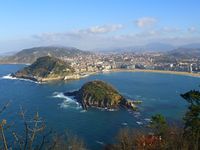
Parts of the city
As a result of Donostia's sprawling in all directions, first into the flatlands shaped by the river Urumea and later up the hills, new districts arose since the walls of the city were demolished in 1863. The first expansion of the old town stretched out to the river's mouth, on the old quarter called Zurriola (a name later given by Council decision to the sand area and the street across the river).
The orthogonal layout nowadays making up the city centre (the Cortazar development) was built up to 1914 (first phase finished) much in tune with a Parisian Haussmannian style. The arcades of the Buen Pastor square were fashioned after the ones of the Rue de Rivoli, with the Maria Cristina Bridge being inspired in the Pont Alexandre III that spans the Seine. The Estación del Norte train station standing right across the bridge was inaugurated in 1864 just after the arrival of the railway to Donostia, with its metallic shelter being designed by Gustave Eiffel.
Parte Vieja
Parte Vieja (Old Part) is the traditional core area of the city, which was surrounded by walls up to 1863, when they were demolished so as to occupy the stretch of sand and land that connected the town to the mainland (a stretch of the walls still limits the Old Part on its exit to the port through the Portaletas gate). The Old Part is divided in two parishes relating to the Santa Maria and San Vicente churches, the inhabitants belonging to the former being dubbed traditionally joxemaritarrak, while those attached to the latter are referred to as koxkeroak. Historically, the koxkeroak up to the early XVIIIth century were largely Gascon speaking inhabitants. Especially after the end of Franco's dictatorship, scores of bars sprang up all over the Old Part, very popular with the youth and the tourists, although not as much with the neighbours. Most current buildings trace back to the XIXth century, erected thanks to the concerted effort and determination of its dwellers after allied forces of Spain looted and burnt down the town (1813).
There is a small fishing and recreation port, with two-floor picturesque houses lined under the front-wall of the mount Urgull. Yet these houses are relatively new, resulting from the demilitarization of the hill, sold to the city council by the Ministry of War in 1924.
Antiguo
This part stands at the west side of the city beyond the Miramar Palace. It is arguably the first population nucleus, even before the land at the foot of Urgull (Old Part) was settled. A monastery of San Sebastián el Antiguo ('the Old') is attested in documents at the time of the foundation (XIIth century). At the mid XIXth century, industry developed (Cervezas El León, Suchard, Lizarriturry), the nucleus coming to be populated by workers. Industry has since been replaced by services and the tourist sector. The Matia kalea provides the main axis for the district.
Amara Zaharra
Or Old Amara, named after the farmhouse Amara. It has eventually merged with the city centre to a large extent, since former Amara lay on the marshes at the left of the River Urumea. The core of this district is the Easo Plaza, with the railway terminal of Euskotren closing the square at its south.
Amara Berri
This city expansion to the south came about as of the 1940s, after the works to canalize the river were achieved. Nowadays the name Amara usually applies to this sector, the newer district having overshadowed the original nucleus both in size and population. The district harbours the main road entrance to the city, with Donostia's central bus station being located between the roundabout and the river. Facilities of many state run agencies were established here and presently Amara's buildings house many business offices. The district revolves around the axis of Avenida Sancho el Sabio and Avenida de Madrid.
Gros
The district is built on the sandy terrain across the river. The Gros or Zurriola beach by the river's mouth bears witness to that type of soil. In the 19th century, shanties and workshops started to dot the area, Tomas Gros being one of its main proprietors as well as providing the name for this part of the city. Gros held the former monumental bullring Chofre demolished in 1973, on a site currently occupied by a housing estate. The district shows a dynamic commercial activity, recently boosted by the presence of the Kursaal Congress Centre by the beach.
Egia
Egia, stemming from (H)Egia (Basque for either bank/shore or hill), is a popular district of Donostia on the right side of the Urumea beyond the train station. At the beginning of the 20th century a patch of land by the railway started to be used as a football pitch, eventually turning into the official stadium of the local team Real Sociedad before it was transferred in the 1990s to Anoeta, south of Amara Berri (nowadays the site harbours houses). The cigarette factory conjures up the former industrial past of the area, while the building has been made recently into a Contemporary Culture Centre. Right opposite to this building lies the Cristina Enea park, a public compound with a botanic vocation. Egia holds the city cemetery, Polloe, at the north-east fringes of the district, stretching out to South Intxaurrondo.
Intxaurrondo
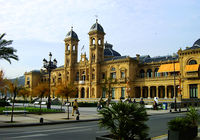
This part (meaning 'walnut tree' in Basque) is a large district to the east of the city. The original nucleus lies between the railway and the Ategorrieta Avenue, where still today the farmhouse Intxaurrondo Zar, declared "National Monument", is situated since the mid-17th century. The railway cuts across the district, the southern side being the fruit of the heavy development undergone in the area during the immigration years of the '50s and '60s. In addition, further housing estates have been built up more recently souther beyond the N-1 E-5 E-80 E-70 ring road (South Intxaurrondo). The paramilitary body Guardia Civil owns a controversial compound and headquarters there (works for new housing are underway).
Altza
Altza (Basque for alder tree) is the easternmost district of San Sebastián along with Bidebieta and Trintxerpe. It was but a quaint village comprising scattered farmhouses and a small nucleus a century ago (2,683 inhabitants in 1910), yet on the arrival of thousands of immigrants in the 50s and 60s a rapid and chaotic housing and building activity ensued, resulting in a maze of grey landscape of skyscrapers and 32,531 inhabitants crammed in them (data of 1970, some 50,000 in 1996). A scheme for the improvement of the area and the construction of a new housing estate (Auditz Akular) is under way in the late 2000s.
Trintxerpe
This tip of San Sebastián's eastern sprawl lies actually on the bank of the Bay of Pasaia, next to the neighbourhood San Pedro from the latter. It was heavily populated in the 50s and 60s with population pouring in mainly from Galicia, who crammed in grey tone functional buildings with little regard to aesthetics.
Ibaeta
Ibaeta stands on the former location for various factories (e.g. Cervezas El Leon) of San Sebastián, with the buildings of the old industrial estate being demolished in the late 20th century. The levelling of this large flat area paved the ground for a carefully planned modern and elegant housing estate, featuring a new university campus for the public University of the Basque Country (UPV-EHU) and institutions such as the Donostia International Physics Center. A stream called Konporta flows down along the eastern side of the area, but it was canalized under the ground almost all along to its mouth on the bay pushed by urban building pressure.
Loiola
It lies by the Urumea at the south-east end of the city. It comprises a small patch of detached houses (Ciudad Jardín) and a core area of 6-odd floor buildings. The district has recently gone through a major makeover, with works finishing in 2008. The road axis coming from important industrial areas (Astigarraga-Hernani) crosses the district heading downtown. Military facilities (home to an uprising in 1936) stand across the river. Attempts by the city council to get them back from the military have been unsuccessful so far.
Martutene
The district bordering to the south on the town of Astigarraga comes next to Loiola in the south direction. This part of the city features an industrial area, a football pitch for lower leagues, a disused vocational training building and enclosure as well as a prison, much in decay and due to be transferred soon to a new location, probably in the municipality's exclave of Zubieta, while this option is coming in for much opposition.
Igeldo
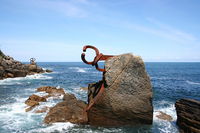
This rural quarter is almost a small town in its own right (many neighbours advocate for a municipality of its own), located at the mountain range of the same name towering over the west side of the Bay of La Kontxa or Concha (Kontxako Badia). At the nearest point of the bay lies a permanent fairground at the hillock Mendiotz, topped by a conspicuous mock military tower (actually built up at the beginning of the XXth century for tourism) which houses a hotel. There is a frequented camp-site on the area.
Zubieta
The exclave Zubieta (meaning 'place of bridges') was a picturesque old village up to recent years, with a bunch of houses, a unique handball pitch (on account of its single wall as opposed to the regular two) and a church. Yet it has undergone a great urban development, which has rendered the location a built-up area with paved streets and due equipment. Two contested projects are under way to build a solid-waste incinerator and a prison nearby. Historically, neighbours from Donostia held a meeting at a house in the former village in the wake of the 1813 burning, in order to decide the reconstruction of the town.
History
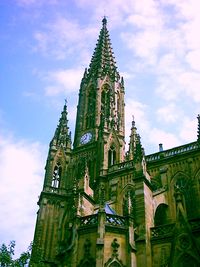
Archeological research has unearthed remains of a small settlement from the Roman age.
- 1014 The monastery of St. Sebastián, in the term of Hernani is donated to the Abbey of Leire by Sancho III of Pamplona.
- 1150 The city is chartered (given fuero) by king Sancho VI of Pamplona, having jurisdiction over all the territory between the rivers Oria and Bidasoa. The city nucleus at the foot of Urgull was populated with Gascon-speaking colonizers from Bayonne.
- 1200 The city is conquered by Castile, whose king Alfonso VIII, confirms its fuero.
- 1265 The use of the city as a seaport is granted to Navarre as part of a wedding pact.
- 1656 The city is used as the royal headquarters during the marriage of the Infanta to Louis XIV at St Jean de Luz nearby.
- San Sebastián is the homeport of most Spanish corsary ships.
- 1728 The foundation of the "Real Compañía Guipuzcoana de Caracas" boosts commerce with the Americas.
- 1808 Napoleonic forces capture San Sebastián in the Peninsular War.
- 1813 On 31 August, British and Portuguese troops besieging San Sebastián defeat French occupying troops. The relieving troops lost all self-control and burnt down the city. Only the street at the foot of the hill (now called 31 August Street) remains.
- 1813 The city is rebuilt in the same spot but with a slightly altered layout, but architecturally in much the same style.
- 1833 British volunteers under Sir George de Lacy Evans defend the city against Carlist attack. Their fallen are buried at the "English Cemetery" on Monte Urgull.
- 1863 The city walls are demolished (their remains are visible in the underground carpark at the Boulevard) and an expansion of the city begins.
- The city was chosen by the Spanish monarchy to spend the summer following the French example of the near Biarritz. Subsequently the Spanish nobility and the diplomatic corps opened residences in the summer capital. As the "wave baths" at La Kontxa or Concha conflicted with shipbuilding activity, shipyards relocate to Pasaia, a near bay formerly part of San Sebastián.
- 1875 Beginning of shelling over the city by Carlists, causing acclaimed bertsolari and poet Bilintx to die in 1876.
- 1885 King Alfonso XII of Spain's widow Maria Cristina spends her summer in Donostia on a yearly basis (takes lodging at the Miramar Palace), bringing along her retinue.
- 1887 The Casino is erected, which eventually turned into the current city hall.
- 1914 Following the outbreak of World War I, San Sebastián becomes an attracting focus for renowned international figures of culture and politics, e.g. Mata Hari, Leon Trotsky, Maurice Ravel, Romanones, etc.
- 1930 Spanish republican forces sign up the San Sebastián Pact leading to the Second Spanish Republic.
- 1936 The military coup is defeated by resistance lead by the Basque Nationalists.[4]
- 1936 The province falls to Spanish Nationalist forces in the Spanish Civil War.[5]
- 1953 The San Sebastián International Film Festival begins.
- 1968 First State of Emergency imposed on Gipuzkoa by Franco's regime, with several more ensuing up to 1975.
- 1973 Iconic buildings Kursaal and the Chofre bullring in Gros demolished. Part of the Kursaal building, all the marble stone, was stolen by Franco to build his burial place in el Valle de los Caídos (the valley of the fallen)in Madrid.
- 2010 Sir Gilbert Mackereth indicent: San Sebastián generates international outcry in response to proposed digging up and disposing of body of World War One hero Sir Gilbert Mackereth who is buried in a San Sebastian cemetery[6]
Sport
Donostia is the home city of the football (soccer) club Real Sociedad, who have recently been promoted back to La Liga after winning the 2009-2010 La Segunda championship. The city's Anoeta Stadium also hosts rugby union matches featuring Biarritz Olympique. Each summer the city is host to the well known bicycle race, the one-day Clásica de San Sebastián.
Food
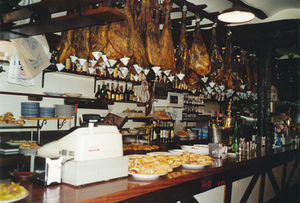
Donostia is renowned for its Basque cuisine. San Sebastián and its surrounding area is home to a high concentration of restaurants boasting Michelin stars, namely Arzak (San Sebastián), Berasategi (Lasarte), Akelarre (district Igeldo) or Mugaritz (Errenteria) to mention but a few. Adding to these cooking highlights, the city features tasty snacks similar to tapas called pintxos, which may be found at the bars of the Old Part.
Culture
The bid by San Sebastián to become European Capital of Culture in 2016 has now defined its basic idea, which the entire project will revolve around: "Waves of people's energy". This basic idea sums up the “soul” of the “San Sebastián 2016” candidature in a clear message: people and movements of citizens are the real driving force behind transformations and changes in the world. They provide the vital civic energy that makes societies advance and progress. Citizens, in short, play the leading role in the search for solutions to new global challenges.
Events
Cultural events
- San Sebastián International Film Festival is held in the city in September.
- San Sebastián's Jazz Festival, the longest, continuously running Jazz Festival in Europe, is held in the last week of July[1].
- Street Zinema is an international audiovisual festival exploring contemporary art and urban cultures[2]
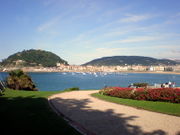
San Sebastián Day
Every year on 20 January (the feast of Saint Sebastian), the people of San Sebastián celebrate a festival known as the "Tamborrada". At midnight, in the Konstituzio plaza in the "Alde Zaharra/Parte Vieja" (Old Part), the mayor raises the flag of San Sebastián (see in the infobox). For 24 hours, the entire city is awash with the sound of drums. The adults, dressed as cooks and soldiers, march around the city. They march all night with their cook hats and white aprons with the March of San Sebastián.
On this day a procession was held in the early 19th century from the Santa Maria Church in the Old Part to the San Sebastián Church in the district of Antiguo, while later limited on the grounds of weather conditions to the in-wall area. The event finished with a popular dancing accompanied on the military band's flutes and drums. In addition, every day a soldier parade took place to change the guards at the town's southern walls. Since the San Sebastián Day was the first festival heralding the upcoming Carnival, it's no surprise that some youths imbued with the Carnival mood followed them aping their martial manners and drumrolls, using for the purpose the buckets left at the fountains. This may have developed into informal youth music groups, with each individual dressing up as they fancied. However, tradition goes that in 1881 unusable military outfit was found in the San Telmo Headquarters. The Town Council decided to grant them to the Union Artesana club so that they could hand them over to their drum-players. Bakers (nowadays cooks) joined the parades sporting barrels donated by Vicente "Txiki" Buenechea to be used as drums. Other clubs followed suit, the festival taking on at the turn of the century the shape of the present-day mixed military and civil style celebration, enlivened by popular music composer Raimundo Sarriegui's much cherished tunes, such as the "San Sebastián March" (1861).[7]
Adults usually have dinner in sociedades gastronómicas ("gourmet clubs"), which provide elements of the procession, and which traditionally admitted only males. Nowadays, even the strictest ones allow women on the "Noche de la Tamborrada". They eat sophisticated meals cooked by themselves, mostly composed of seafood (traditionally elvers, now no longer served due to its exorbitant price) and drink the best wines. For "Donostiarras" this is the most celebrated festival of the year.
After hearing drums all night, children wake up with a version of the Tamborrada for kids. Children dress traditionally as soldiers and march around the city. Children from all the schools of San Sebastián march that day. They have their specific costumes which usually represent a particular country (France, England, Germany, etc.)
Semana Grande / Aste Nagusia
A festival called Semana Grande in Spanish and Aste Nagusia in Basque ("Big/Main Week") is held every year at mid-August. An important international fireworks contest takes place, in which a fireworks presentation is made every night over the bay and, at the end, the contest's winner is declared. Other features of the festival include brass bands enlivening the streets, popular music performances at and by the beach, as well as fairground attractions arranged at the seaside promenade Paseo Nuevo.
Basque Week
This decades long festivity taking place at the beginning of September features events related to Basque culture, such as performances of traditional improvising poets (bertsolaris), Basque pelota games, stone lifting contests, oxen wagers, dance exhibitions or the cider tasting festival. Yet the main highlight may be the rowing boat competition, where teams from different towns of the Bay of Biscay contend for the Flag of La Concha or Kontxa. Thousands of supporters coming from these coastal locations pour into the city's streets and promenades overlooking the bay to follow the event, especially on the Sunday of the final race. All day long the streets of the Old Part play host to droves of youths clad in their team colours who party there in a cheerful atmosphere.
Santa Ageda Bezpera
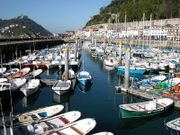
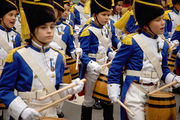
Saint Agatha's Eve is a traditional event taking place at the beginning of February or end of January in many spots of the Basque Country. It holds a small but cherised slot in the city's run-up to the Carnival. Groups dressed up in Basque traditional farmer costume march across the neighbourhood singing and wielding a characteristic stick beaten on the ground to the rhythm of the traditional Saint Agatha's tune. The singers ask for a small donation, which can be money, a drink or something to eat.
Caldereros
This is a local festival held on the first Saturday of February linked to the upcoming Carnival, where different groups of people dressed in Romani (Gypsy) tinkers attire take to the streets banging rhythmically a hammer or spoon against a pot or pan, and usually bar-hop while they sing the traditional songs for the occasion. They were just men voices some time ago, but women participate and sing currently too. The festival is 125 years old in 2009.
Santo Tomas
This popular festival takes place on the 21 December, a date frequently shrouded in winter cold. From early in the morning, stalls are arranged across the city centre and people from all Gipuzkoa flock to the streets of the centre and the Old Part, with crowds of people often dressed in traditional Basque "farmer" outfit turning out and filling the area. Traditional and typical produce is showcased and sold on the stalls, while the main drink is cider and the most popular snacks are txistorra (a type of thin, uncured chorizo) wrapped in talos (flatbread). A large pig is on display in the Konstituzio Plaza, which is raffled off during the festival.
Olentzero
As in other Basque cities, towns and villages, on Christmas Eve the Olentzero and the accompanying carol singers usually dressed in Basque farmer costume take over the streets, especially in the city centre, asking for small donations in bars, shops and banks after singing their repertoire. Sometimes Olentzero choirs roam around the streets in later dates, on the 31st for example, and are often related to cultural, social or political associations and demands.
Sport
The principal football club is Real Sociedad de Fútbol, S.A.D. (more commonly referred to as Real Sociedad). It plays at the Estadio Anoeta, which seats 32,000 spectators. After two seasons in La Segunda, the club won promotion back to La Liga and will participate in the top division for the 2010-2011 season.[8] Real Sociedad was one of the founding members of the Spanish football league - La Liga. It enjoyed a particularly successful period of its history in the early 1980s when it was the Spanish champion two years running (1980-81, 1981-82).
Cycling is also extremely popular in Spain, the Clásica de San Sebastián (San Sebastián Classic) processional cycle race is held during early August. It has been held annually in San Sebastián since 1981. The race is part of the UCI ProTour and was previously part of its predecessor the UCI World Cup.
Famous people from San Sebastián
- Luis Miguel Arconada Etxarri, (born 26 June 1954) is a former Real Sociedad and Spain's team footballer, as goalkeeper.
- Mikel Arteta, professional footballer, formerly of local team Real Sociedad and Scottish Premier League team Glasgow Rangers and now playing for English Premier Division side Everton.
- Serafin Baroja (1840-1912), writer, Basque culture advocate and liberal. Father of Pio Baroja.
- Indalezio Bizkarrondo "Bilintx" (1831-1876), a romantic poet and bertsolari closely attached to the city. Died tragically after being hit by Carlist shelling.
- Achille Broutin (1860-1918), fencer and collector of weapons.
- Emmanuel Broutin (1826-1883), fencer.
- Eduardo Chillida (1924–2002), sculptor, notable for his monumental abstract works.
- Rafael Echagüe y Bermingham, governor of Puerto Rico and Philippines.
- Alfredo Goyeneche , president of Spanish olympic committee.
- Alberto Iglesias, music composer.
- Jesús María de Leizaola, President of the Basque Government in exile after 1960.
- Sir Gilbert Mackereth, British World War I hero, holder of Military Cross for gallantry. Retired to live in San Sebastián and died there 1962, interred at San Sebastián Cemetery.[9]
- Iker Martínez de Lizarduy Lizarribar, olympic sailor.
- Miguel Muñoa Pagadizabal , philanthropist.
- Julio Medem, film director.
- Mercedes Quesada Etxaide, mother of the former President of Mexico, Vicente Fox
Twin cities
 Daira de Bojador, Western Sahara
Daira de Bojador, Western Sahara Marugame, Japan
Marugame, Japan Plymouth, United Kingdom
Plymouth, United Kingdom Reno, USA
Reno, USA Trento, Italy
Trento, Italy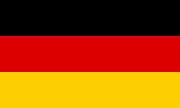 Wiesbaden, Germany
Wiesbaden, Germany Batumi, Georgia
Batumi, Georgia

Notes
- ↑ The nickname of la bella Easo ("beautiful Easo") comes from a 19th-century identification of the town as the Roman port of Oiasso. Other locations seem now more probable.
- ↑ Trask, L. The History of Basque Routledge: 1997 ISBN 0-415-13116-2
- ↑ "Valores Climatológicos Normales. San Sebastián / Aeropuerto". http://www.aemet.es/es/elclima/datosclimatologicos/valoresclimatologicos?l=1014&k=pva.
- ↑ Hugh Thomas, Spanish Civil War, (2001), p. 226
- ↑ Hugh Thomas, (2001), p. 397.
- ↑ Sir Gilbert Mackereth indicent
- ↑ Sadaba, Javier; Sadava, Asier (1995). Historia de San Sebastián. Editorial Txertoa. pp. 107–110. ISBN 84-7148. Book in Spanish
- ↑ http://www.goal.com/en/news/12/spain/2010/06/14/1974996/real-sociedad-levante-promoted-to-primera-liga
- ↑ BBC News Report
External links
- Official website
- Tourist information
- Official website of the candidature to European Capital of Culture 2016
- Images of San Sebastián in 1909
- Photos of San Sebastián
- Donostia photos
- San Sebastián - Donostia Photo Gallery
- "Donostia" group on Flickr
- DONOSTIA in the Bernardo Estornés Lasa - Auñamendi Encyclopedia (Euskomedia Fundazioa) (Spanish)
|
|||||||

